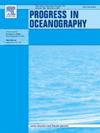Distribution patterns of deep-sea molluscs from the Bering Sea and Aleutian Trench
IF 3.6
3区 地球科学
Q1 OCEANOGRAPHY
引用次数: 0
Abstract
The Aleutian Trench, a canyon-like structure in the deep sea floor that parallels the southern fringe of the Aleutian Islands off Alaska, has only been studied by a few previous expeditions. The trench itself and the adjacent island archipelago both present potential dispersal barriers to marine species, which may shape the regional biogeography. We report new findings on the molluscan fauna of the trench and adjacent regions, from the recent “AleutBio” expedition in summer 2022 on the German research vessel Sonne. We recovered over 4300 individual mollusc specimens representing 212 identified taxa in 7 classes (all living taxonomic classes except Polyplacophora), of which 180 could be assigned to a species-level morphospecies. Highlights from our new material include: one monoplacophoran, the dumbo octopus Grimpoteuthis imperator re-collected for the first time since its description, the deepest record for the large-bodied solenogaster family Neomeniidae at 6612 m, the very rare columbariid gastropod Tropidofusus aequilonius, and new hadal records for several bivalves: Rengea murrayi, Limatula cf. vancouverensis, Neilonella abyssopacifica, Neilonella politissima, Catillopecten squamiformis, Parvamussium pacificum, and Setigloma japonica and the bivalve family Sareptidae. Comparing records from the Bering Sea (3490–3655 m), the north rim of the trench (4220–4641 m), the hadal depths of the trench bottom (6181–7287 m), and the southern rim (4790–5330 m), provides a test of potential barriers to the distributions of species across these regions. Of the species found in the Bering Sea, 63 % are also found in the broader Aleutian Trench region. Similarly, of the mollusc species found on the south rim of the trench, 68 % cross the Aleutian Trench and are found on the north rim and/or in the Bering Sea. The dispersal potential of most mollusc species is apparently not restricted by deep-sea trenches or island chains in the North Pacific.
白令海和阿留申海沟深海软体动物的分布模式
阿留申海沟是深海底的一个峡谷状结构,与阿拉斯加外的阿留申群岛南部边缘平行,以前只有几次探险对它进行了研究。海沟本身和邻近的岛屿群岛都对海洋物种的扩散构成了潜在的障碍,这可能会影响区域生物地理。我们报告了关于海沟和邻近地区软体动物动物群的新发现,这些发现来自最近在2022年夏天由德国研究船Sonne进行的“阿留申生物”考察。本研究共回收软体动物7纲212个分类群4300余件标本,其中180余件标本属于种级形态种。新资料的亮点包括:一种单placophoran,一种自描述以来首次收集到的小飞象章鱼grimpoteus, 6612米深的大型螺螺鱼科Neomeniidae的最深记录,一种非常罕见的柱状纲腹足类Tropidofusus aequilonius,以及几种双壳类的新hadal记录。Rengea murrayi, limmatula cfverensis, Neilonella abyssopacifica, Neilonella politissima, Catillopecten squamiformis, parvamusum pacificum, Setigloma japonica和双壳科sareptitidae。对比白令海(3490-3655 m)、海沟北缘(4220-4641 m)、海沟底部(6181-7287 m)和海沟南缘(4790-5330 m)的记录,为物种在这些地区分布的潜在障碍提供了一个测试。在白令海发现的物种中,63%也在更广阔的阿留申海沟地区发现。同样,在海沟南缘发现的软体动物物种中,68%穿过阿留申海沟,在北缘和/或白令海中发现。大多数软体动物物种的扩散潜力显然不受北太平洋深海海沟或岛链的限制。
本文章由计算机程序翻译,如有差异,请以英文原文为准。
求助全文
约1分钟内获得全文
求助全文
来源期刊

Progress in Oceanography
地学-海洋学
CiteScore
7.20
自引率
4.90%
发文量
138
审稿时长
3 months
期刊介绍:
Progress in Oceanography publishes the longer, more comprehensive papers that most oceanographers feel are necessary, on occasion, to do justice to their work. Contributions are generally either a review of an aspect of oceanography or a treatise on an expanding oceanographic subject. The articles cover the entire spectrum of disciplines within the science of oceanography. Occasionally volumes are devoted to collections of papers and conference proceedings of exceptional interest. Essential reading for all oceanographers.
 求助内容:
求助内容: 应助结果提醒方式:
应助结果提醒方式:


